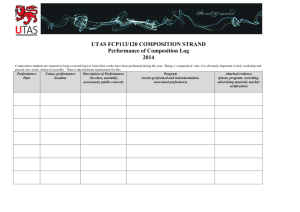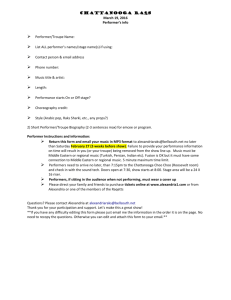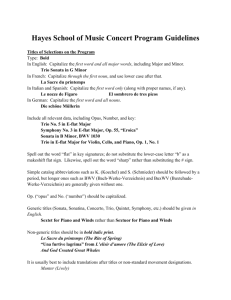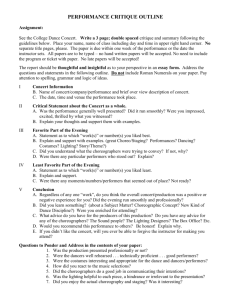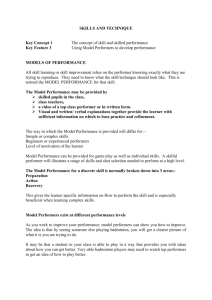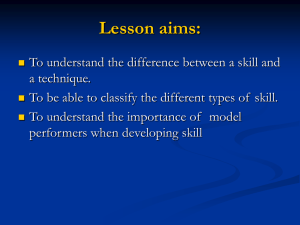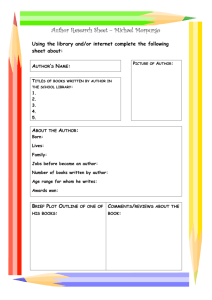Crane Concert Program Guidelines
advertisement
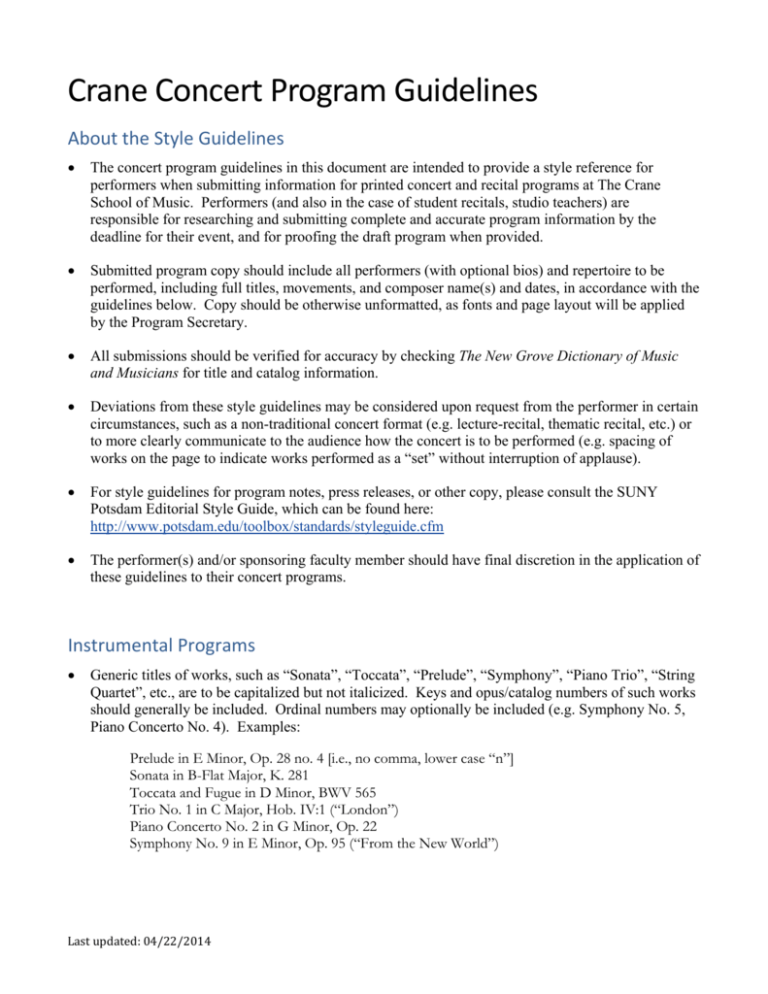
Crane Concert Program Guidelines About the Style Guidelines The concert program guidelines in this document are intended to provide a style reference for performers when submitting information for printed concert and recital programs at The Crane School of Music. Performers (and also in the case of student recitals, studio teachers) are responsible for researching and submitting complete and accurate program information by the deadline for their event, and for proofing the draft program when provided. Submitted program copy should include all performers (with optional bios) and repertoire to be performed, including full titles, movements, and composer name(s) and dates, in accordance with the guidelines below. Copy should be otherwise unformatted, as fonts and page layout will be applied by the Program Secretary. All submissions should be verified for accuracy by checking The New Grove Dictionary of Music and Musicians for title and catalog information. Deviations from these style guidelines may be considered upon request from the performer in certain circumstances, such as a non-traditional concert format (e.g. lecture-recital, thematic recital, etc.) or to more clearly communicate to the audience how the concert is to be performed (e.g. spacing of works on the page to indicate works performed as a “set” without interruption of applause). For style guidelines for program notes, press releases, or other copy, please consult the SUNY Potsdam Editorial Style Guide, which can be found here: http://www.potsdam.edu/toolbox/standards/styleguide.cfm The performer(s) and/or sponsoring faculty member should have final discretion in the application of these guidelines to their concert programs. Instrumental Programs Generic titles of works, such as “Sonata”, “Toccata”, “Prelude”, “Symphony”, “Piano Trio”, “String Quartet”, etc., are to be capitalized but not italicized. Keys and opus/catalog numbers of such works should generally be included. Ordinal numbers may optionally be included (e.g. Symphony No. 5, Piano Concerto No. 4). Examples: Prelude in E Minor, Op. 28 no. 4 [i.e., no comma, lower case “n”] Sonata in B-Flat Major, K. 281 Toccata and Fugue in D Minor, BWV 565 Trio No. 1 in C Major, Hob. IV:1 (“London”) Piano Concerto No. 2 in G Minor, Op. 22 Symphony No. 9 in E Minor, Op. 95 (“From the New World”) Lastupdated:04/22/2014 Titles of complete works should be listed as printed in the score or in the composer’s catalog, without quotation marks. Titles of complete works may optionally be italicized, retaining the upper/lower-case of the original. Opus/catalog numbers should generally be included. Examples: Billy the Kid: Suite Americana, Op. 96a (1992) The Gumsuckers March (1914) Meeresstille und glückliche Fahrt, Op. 27 Prélude à l'après-midi d'un faune Foreign titles known equally well under their English titles may be listed either way. Titles in Cyrillic or other non-Western alphabets should generally be transliterated. Examples: Le Sacre du printemps Ne poy, krasavitsa, pri mne - OR - The Rite of Spring Catalog numbers should be abbreviated and capitalized: Opus: Op. Köchel: K. Longo: L. Traditional descriptive names of works should be placed at the end of the work information, using quotation marks and parentheses: Sonata No. 17 in D Minor, Op. 31 no. 2 (“Tempest”) Ludwig van Beethoven (1770–1827) Premieres of works may so be indicated: From the Depths of Time (2014) Frank Milquetoast (b. 2001) World Premiere Dates of composition may be included at the discretion of the performer, especially for works that have no opus or catalog number, or when the performer wishes to provide a context for the work: Lament (1998) Christopher Tilley (b. 1970) When performing complete multi-movement works, the names or tempo indications of each movement should generally be printed below the title, indented and single spaced: Sonata in B-Flat Major, K. 281 Allegro moderato Andante amoroso Allegro Lastupdated:04/22/2014 Wolfgang Amadeus Mozart (1756–1791) P a g e |2 When performing selected portions of a multi-movement work, Roman numerals may be added to indicate which portions of the work are being performed. The periods should be right-aligned, followed by a single space: Sonata in B-Flat Major, K. 281 I. Allegro moderato III. Allegro Wolfgang Amadeus Mozart (1756–1791) Klavierstücke, Op. 118 I. Intermezzo V. Romance Johannes Brahms (1833–1897) Symphony No. 0 in D Minor (“Die Nullte”) III. Scherzo: Presto IV. Finale, moderato – Allegro vivace Anton Bruckner (1824–1926) Alternatively, when performing selected portions of a multi-movement work, the word “from” (with a lower case “f”) may be used to indicate which movement or movements of the work is/are being performed, followed by the italicized title: from Sketches for Friends Lobster Tale November Song Brian Head (b. 1964) Composers Use full names for composers and list applicable birth and death dates in parentheses under name. Both lines will be right-justified. For deceased composers, separate the birth year from the death year using an en dash (–), without spaces before or after the dash. On a Macintosh computer, create using <Option> plus “hyphen”; on a PC create using <Ctrl> plus “hyphen” on the number pad, or using <Alt> plus the numbers 0150 on the right-side number pad. Johann Sebastian Bach (1685–1750) For living composers, indicate the birth year with “b. ” followed by a single space: John Corigliano (b. 1938) In the event a composer appears more than once on a program, dates should be provided for the first occurrence only. Lastupdated:04/22/2014 P a g e |3 If a work has been adapted, arranged, or transcribed, include both the name and dates of the composer (with dates) and the adapter/arranger/transcriber (without dates). Abbreviate “arranged,” “transcribed,” and “adapted” as follows: “arr.”, “trans.”, and “adapt.” Allegro Joseph Hector Fiocco (1703–1741) arr. Sigurd Rascher See also section below, Vocal Programs, for more specific information pertaining to sets of songs and arias, and other vocal repertoire-specific concerns. Performer Credits All performers should be listed by full name followed by a comma, then their instrument or voice type (uncapitalized). Pianists in an accompanying or collaborative role should be listed as “piano.” Examples: Clara Rockmore, theremin Gerald Moore, piano Lilli von Stupp, mezzo-soprano (not “thereminist”) (not “accompanist”) Non-instrumental performer credits should be listed in the same manner: Herbert von Karajan, conductor Patrick Stewart, narrator In cases where multiple performers are performing on the same instrument, list the performers separated by commas, then the instrument in plural form: Raphael Sanders, Julianne Kirk-Doyle, clarinets For programs with multiple performers performing only one or two works (such as a faculty gala, or a performer joining for only a single work), those performers should be listed below each selection to be performed. In cases when smaller numbers of faculty are performing a group recital (such as a voice faculty concert), all performers may be listed at the top of the program and also listed below each selection to be performed. In such subsequent listings, performers may be identified by Mr., Ms., Dr., etc.: Piano Faculty Recital Rudolf Serkin, Alfred Brendel, and Martha Argerich Sonata for Two Pianos in D Major, K. 448 Wolfgang Amadeus Mozart (1756–1791) Mr. Serkin, Mr. Brendel - OR Rudolf Serkin, Alfred Brendel Lastupdated:04/22/2014 P a g e |4 Performer Bios Bios of faculty and student performers are generally not included in concert programs. However, guest artists and students performing as a featured soloist with an ensemble may submit bios of up to 100 words for inclusion in the program. Vocal Programs Single song titles (not from larger works) should be printed non-italicized, even when in a foreign language. Multiple such songs from the same composer should be single spaced. Examples: Già il sole dal Gange Alessandro Scarlatti (1660–1725) Le papillon et la fleur Lydia Au bord de l’eau Gabriel Fauré (1845–1924) Keys and opus numbers are typically not included for individual song titles, though opus number may be included if performing an entire cycle or more than one selection from a larger work. Poets may optionally be listed in parentheses: Mandoline (Verlaine) Gabriel Fauré (1845–1924) Aria titles from operas, oratorios, and cantatas are generally capitalized as sentences (initial capital only), while titles of songs from musicals and generally have each word capitalized, with certain exceptions (some oratorio, in particular). In general, follow the capitalization of the text as printed in the score. Et exultavit spiritus meus in Deo salutari meo from Magnificat, BWV 243a When performing an aria with a recitative, the recitative title should be separated from the aria title with an ellipsis ( … ). Include a space on each side of the ellipsis. Giunse alfin il momento … Deh vieni, non tardar from Le Nozze di Figaro Johann Sebastian Bach (1685–1750) Wolfgang Amadeus Mozart (1756–1791) When performing multiple selections from a collection, opera, or musical, italicize the name of the collection, opera, or musical, and list the selections (non-italicized) below the title, indented, without quotation marks. Use “from” to indicate a portion of the work is to be performed; list the title alone to indicate the entire work is being performed. A portion of a larger work: from Cowboy Songs Bucking Bronco Billy the Kid Lastupdated:04/22/2014 Libby Larsen (b. 1950) P a g e |5 from Falstaff L’onore! Ladri! Tutto nel mondo è burla Giuseppe Verdi (1813–1901) A complete work: Despite and Still A last song My lizard In the wilderness Solitary hotel Despite and still Samuel Barber (1910–1981) When performing only one selection from a collection, opera or musical, the work may be listed one of two ways: Bucking Bronco from Cowboy Songs Libby Larsen (b. 1950) - OR Bucking Bronco (Cowboy Songs) Libby Larsen (b. 1950) A Boy Like That from West Side Story Leonard Bernstein (1918–1990) - OR A Boy Like That (West Side Story) Leonard Bernstein (1918–1990) Two or more songs not from a cycle (different composers) are unspaced to indicate a group of works to be performed without interruption of applause: La lune blanche Gabriel Fauré (1845–1924) Reynaldo Hahn (1874–1947) Henri Duparc (1848–1933) L’heure exquise Extase Lastupdated:04/22/2014 P a g e |6
